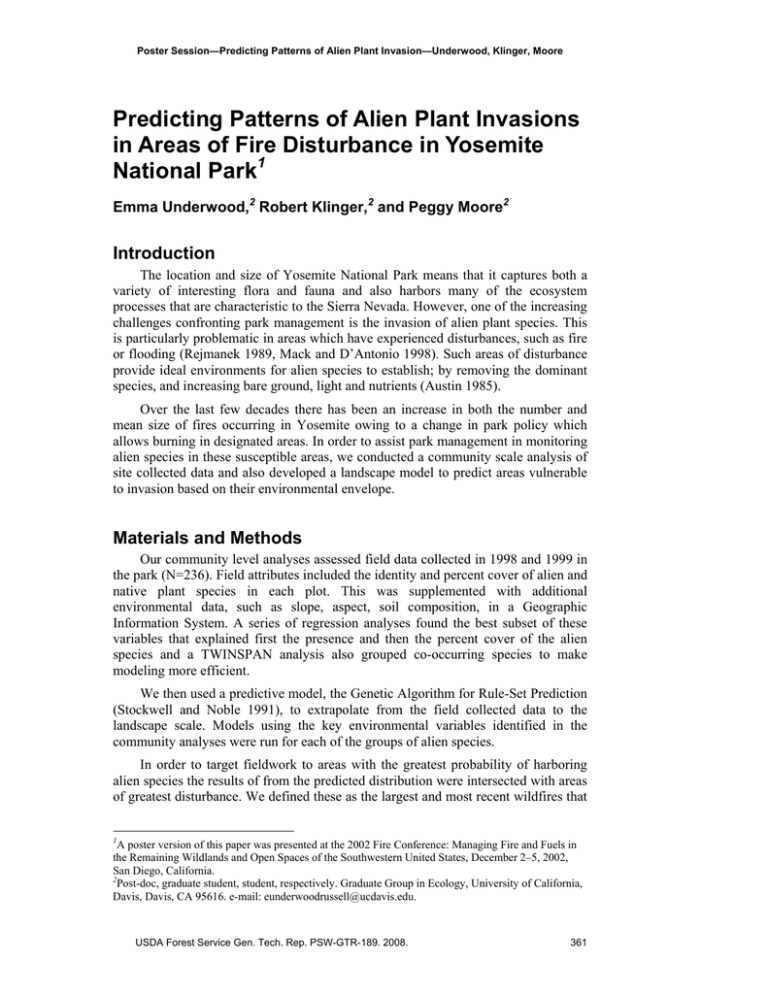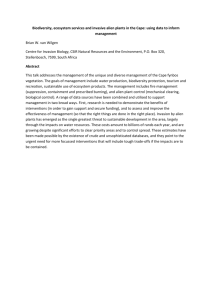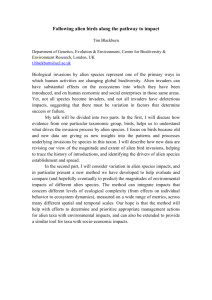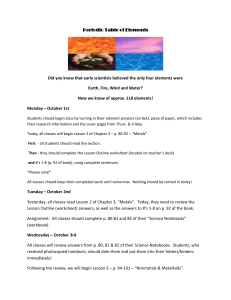Predicting Patterns of Alien Plant Invasions National Park
advertisement

Poster Session—Predicting Patterns of Alien Plant Invasion—Underwood, Klinger, Moore Predicting Patterns of Alien Plant Invasions in Areas of Fire Disturbance in Yosemite National Park1 Emma Underwood,2 Robert Klinger,2 and Peggy Moore2 Introduction The location and size of Yosemite National Park means that it captures both a variety of interesting flora and fauna and also harbors many of the ecosystem processes that are characteristic to the Sierra Nevada. However, one of the increasing challenges confronting park management is the invasion of alien plant species. This is particularly problematic in areas which have experienced disturbances, such as fire or flooding (Rejmanek 1989, Mack and D’Antonio 1998). Such areas of disturbance provide ideal environments for alien species to establish; by removing the dominant species, and increasing bare ground, light and nutrients (Austin 1985). Over the last few decades there has been an increase in both the number and mean size of fires occurring in Yosemite owing to a change in park policy which allows burning in designated areas. In order to assist park management in monitoring alien species in these susceptible areas, we conducted a community scale analysis of site collected data and also developed a landscape model to predict areas vulnerable to invasion based on their environmental envelope. Materials and Methods Our community level analyses assessed field data collected in 1998 and 1999 in the park (N=236). Field attributes included the identity and percent cover of alien and native plant species in each plot. This was supplemented with additional environmental data, such as slope, aspect, soil composition, in a Geographic Information System. A series of regression analyses found the best subset of these variables that explained first the presence and then the percent cover of the alien species and a TWINSPAN analysis also grouped co-occurring species to make modeling more efficient. We then used a predictive model, the Genetic Algorithm for Rule-Set Prediction (Stockwell and Noble 1991), to extrapolate from the field collected data to the landscape scale. Models using the key environmental variables identified in the community analyses were run for each of the groups of alien species. In order to target fieldwork to areas with the greatest probability of harboring alien species the results of from the predicted distribution were intersected with areas of greatest disturbance. We defined these as the largest and most recent wildfires that 1 A poster version of this paper was presented at the 2002 Fire Conference: Managing Fire and Fuels in the Remaining Wildlands and Open Spaces of the Southwestern United States, December 2–5, 2002, San Diego, California. 2 Post-doc, graduate student, student, respectively. Graduate Group in Ecology, University of California, Davis, Davis, CA 95616. e-mail: eunderwoodrussell@ucdavis.edu. USDA Forest Service Gen. Tech. Rep. PSW-GTR-189. 2008. 361 Poster Session—Predicting Patterns of Alien Plant Invasions—Underwood, Klinger, Moore had occurred in the park. We then generated a set of random points to help guide fieldwork for monitoring invasives. Results and Discussion The community level analyses identified elevation, slope, percent tree cover and percent shrub cover as the factors best able to explain the distribution of alien species in the site collected data. Using these key variables, the GARP model was run using a selection of site collected locations to train the model, and the remaining sites were reserved to test the accuracy of the results. The overall accuracy of the model, that is, its ability to successfully predict the invisibility of sites was 76 percent. Our selection of burn areas with the greatest disturbance included the Ackerson, A-rock, Hoover, Leconte, and Steamboat wildfires, which have all occurred since 1990. A total of 200 random points were generated for field work in areas predicted to harbor alien species which fell within these wildfire boundaries. The number of points assigned to each burn was determined by the size of the burn, a minimum distance from the boundary of the burn was specified to avoid spurious edge effects. Conclusions These results provide a foundation for sampling and monitoring alien species within areas of disturbance in Yosemite National Park, and also a means to allocate limited park personnel and financial resources. Fieldwork conducted across a continuum of areas with different accuracy results will also yield important information on the way alien species respond to fire. In the long-term such analyses can be applied to other disturbances in the park, such as areas of flooding or disturbances in the park caused by human visitation, to provide a holistic monitoring plan for alien species. References Austin, M.P.; Groves, R.H.; Fresco, L.M. F.; Kaye, P.E. 1985. Relative growth of six thistle species along a nutrient gradient with multispecies competition. Journal of Ecology 73: 667–684. Mack, M.C.; D'Antonio, C.M. 1998. Impacts of biological invasions on disturbance regimes. Trends in Ecology and Evolution 13: 195–198. Rejmanek, M. 1989. Invasibility of plant communities. In: Drake, J.A.; Mooney, H.A.; DiCastri, F.; Groves, R.H.; Kruger, F.J.; Rejmanek, M.; Williamson, M. eds. Biological invasions: a global perspective. New York: John Wiley & Sons; 369–388. Stockwell, H.M.; Noble, P.H. 1991. Induction of sets of rules from animal distribution data: a robust and informative method of data analysis. Mathematics and Computer Simulation 32: 249–254. 362 USDA Forest Service Gen. Tech. Rep. PSW-GTR-189. 2008.




